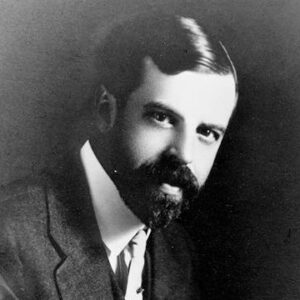Alfred Louis Kroeber was a well-known American anthropologist who was known for his work on the culture of American Indians. Kroeber was the first person to get a Ph.D. in anthropology from Columbia University. He was a very important person in the field of anthropology in the first half of the 20th century.
Even though most of his work in anthropology was about the nature of culture and how it works, he also wrote about a wide range of related topics, such as language, folklore, and social structures. One of his most important contributions was the research he did on the Yahi people. He worked closely with Ishi, the last member of the now-extinct tribe, to do this research. As a social scientist, he thought that all living things should be seen as wholes when it came to their tendencies to grow and change. His own experiences as a child in a German family that had moved to the U.S. sparked his interest in studying how people act based on their culture. In addition to loving anthropology, he also made important contributions to the field of archaeology and was interested in languages his whole life. He worked very hard and was always calm and patient. Because of this, everyone who worked with him had a lot of respect for him.
Early years and childhood
He was born in New Jersey on June 11, 1876. His father, Florence Kroeber, was a German immigrant, and his mother, Johanna Muller, was also German. He was the oldest of his parents’ four kids. When Alfred was young, his family moved to New York.
Dr. Bamberger taught him when he was about seven years old. He later said that Dr. Bamberger was a great teacher who made his students want to learn a lot.
He went to Sachs’ Collegiate Institute, which was a middle school and high school that was based in the German gymnasium. This school helped boys get ready for college.
When he was 16, he went to Columbia College. He got his A.B. in English in 1896 and his M.A. in Romantic drama the next year. But he changed his mind and went into anthropology.
In 1901, he got his Ph.D. in Anthropology from Columbia University for his thesis on the meaning of decorations among the Arapaho, which was based on his work with them in the field. His guide for his Ph.D. had been Franz Boas.
Alfred Kroeber’s Career
In 1901, he started working at the University of California, Berkeley, where he would stay for the majority of his career. In the end, he was both a professor of anthropology and the head of the University of California Museum of Anthropology at the time (now the Phoebe A. Hearst Museum of Anthropology).
Anthropology was a new field at the time, so Kroeber and his peers were given academic jobs that weren’t well-defined and didn’t guarantee a steady income. But with his dedication and hard work, he was able to make anthropology more popular in the end.
His salary at the university was set at $1,200 per year for the first five years he worked there. Along with teaching semesters, he and P.E. Goddard looked into the native languages and cultures of California that were not well known.
In 1923, he wrote the book “Anthropology,” which at the time was one of the most important books on the subject. Since anthropology was a new field, his book was the only way for people who wanted to become anthropologists to learn about it.
Kroeber’s students helped him with his research, and together they did important work studying the Native American tribes of the west. The information they gathered and the research they did were put together in a book called “Handbook of the Indians of California” (1925).
His work in the “area of culture” was very important. In this field, he came up with a number of ideas that were published in 1939 in the book “Cultural and Natural Areas of Native North America.”
In his 1938 book “Basic and Secondary Patterns of Social Organization,” which was later reprinted in the 1952 book “Nature of Culture,” he linked the problems with kinship systems to the question of what is most important and what is less important in a total culture.
“Configurations of Culture Growth,” which he wrote in 1944 and is thought to be one of his best works, is about how culture is more complex than an individual organism. It shows that individual achievements can show culture, but they can’t explain it.
He was also known for working with Ishi, who was thought to be the last Yahi Indian from California. Ishi was taken in by Kroeber and other anthropologists at the University of California, where they talked to and studied him.
Awards & Achievements
In 1912, the American Academy of Arts and Sciences made him a Fellow because of what he had done in the field of anthropology.
He has earned honorary degrees from Yale University, Columbia University, and Harvard, among other well-known schools.
Personal History and Legacies
He married Henrietta Rothschild in 1906. Unfortunately, his wife got tuberculosis and was sick for a number of years before she died of it in 1913.
In 1926, a few years after the death of his first wife, he married a widow named Theodora Kracaw Brown. Kroeber took in Theodora’s two sons from her first marriage. The couple were happy together and had two more kids.
He died at the age of 84 on October 5, 1960.
Estimated Net worth
Unknown.


